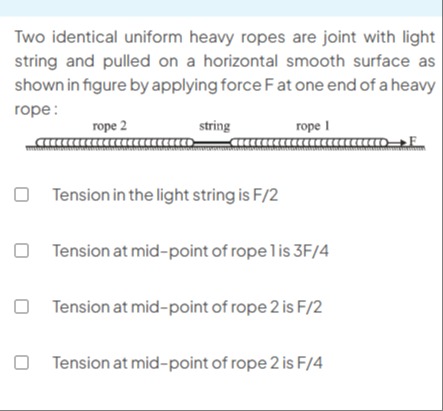Question
Question: Two identical uniform heavy ropes are joint with light string and pulled on a horizontal smooth surf...
Two identical uniform heavy ropes are joint with light string and pulled on a horizontal smooth surface as shown in figure by applying force F at one end of a heavy rope:

Tension in the light string is F/2
Tension at mid-point of rope 1 is 3F/4
Tension at mid-point of rope 2 is F/2
Tension at mid-point of rope 2 is F/4
Tension in the light string is F/2, Tension at mid-point of rope 1 is 3F/4, Tension at mid-point of rope 2 is F/4
Solution
The problem involves two identical uniform heavy ropes connected by a light string, pulled by a force F on a smooth horizontal surface.
Let:
- Mass of each rope = M
- Length of each rope = L
- Applied force = F
Since the surface is smooth, there is no friction. The light string has negligible mass. The entire system moves with a common acceleration.
1. Calculate the acceleration of the system: The total mass of the system is the sum of the masses of the two ropes, as the string has negligible mass. Total mass (Mtotal) = Mass of Rope 1 + Mass of Rope 2 = M + M = 2M. According to Newton's second law, F=Mtotal×a. Therefore, the acceleration of the system (a) is: a=MtotalF=2MF
2. Tension in the light string (Tstring): The light string connects Rope 1 and Rope 2. The tension in the string is responsible for pulling Rope 2. Consider Rope 2 as a free body. The only horizontal force acting on it is the tension from the string. Tstring=Mrope2×a Tstring=M×(2MF) Tstring=2F Thus, the first statement "Tension in the light string is F/2" is correct.
3. Tension at the mid-point of Rope 1 (Tmid1): Rope 1 has mass M and length L. Its midpoint is at L/2 from the point where force F is applied and also L/2 from the string. The tension at the midpoint of Rope 1 is responsible for accelerating the mass of the segment of Rope 1 from its midpoint to the string, plus the mass of the string, plus the mass of Rope 2. Mass of Rope 1 from midpoint to string = 2M (since it's a uniform rope, half the length means half the mass). Mass being pulled by Tmid1 = (Mass of Rope 1 segment) + (Mass of string) + (Mass of Rope 2) Mass being pulled by Tmid1 = 2M+0+M=23M Tmid1=(23M)×a Tmid1=(23M)×(2MF) Tmid1=43F Thus, the second statement "Tension at mid-point of rope 1 is 3F/4" is correct.
4. Tension at the mid-point of Rope 2 (Tmid2): Rope 2 has mass M and length L. Its midpoint is at L/2 from the string and also L/2 from its free end. The tension at the midpoint of Rope 2 is responsible for accelerating the mass of the segment of Rope 2 from its midpoint to its free end (the leftmost end). Mass of Rope 2 from midpoint to free end = 2M. Mass being pulled by Tmid2 = 2M Tmid2=(2M)×a Tmid2=(2M)×(2MF) Tmid2=4F Thus, the fourth statement "Tension at mid-point of rope 2 is F/4" is correct. The third statement "Tension at mid-point of rope 2 is F/2" is incorrect.
Conclusion: The correct statements are:
- Tension in the light string is F/2
- Tension at mid-point of rope 1 is 3F/4
- Tension at mid-point of rope 2 is F/4
